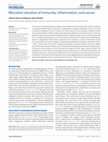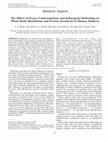Papers by Stephen O'Keefe
Nature communications, Apr 20, 2024
Cancer and Metabolism, May 1, 2014
Nature Reviews Gastroenterology & Hepatology, 2016
Cancer & Metabolism, 2014

South African medical journal = Suid-Afrikaanse tydskrif vir geneeskunde, 2000
Evidence that chronic gastric Helicobacter pylori (HP) infection is an aetiological factor in dys... more Evidence that chronic gastric Helicobacter pylori (HP) infection is an aetiological factor in dyspepsia, peptic ulcer disease, gastric carcinoma and lymphoma has led to the suggestion that all serologically positive dyspeptic patients should be treated empirically with antibiotics to eradicate the infection, without endoscopic diagnosis. The following study was performed to determine whether such a policy would prove to be of benefit in rural Africa, where endoscopic facilities are lacking and infection rates high. Four district clinics were visited and 97 consecutive patients with persistent upper gastro-intestinal symptoms studied. After history-taking and physical examination, a blood sample was taken for HP serology (IgG anti-HP EIA) and endoscopy was performed. In comparison with similar studies in westernised countries HP was considerably more common (80%), and similar to that reported for the background population (83-86%), but peptic ulceration (17%) and gastric cancer (1%) ...

Frontiers in physiology, 2011
The human microbiota presents a highly active metabolic that influences the state of health of ou... more The human microbiota presents a highly active metabolic that influences the state of health of our gastrointestinal tracts as well as our susceptibility to disease. Although much of our initial microbiota is adopted from our mothers, its final composition and diversity is determined by environmental factors. Westernization has significantly altered our microbial function. Extensive experimental and clinical evidence indicates that the westernized diet, rich in animal products and low in complex carbohydrates, plus the overuse of antibiotics and underuse of breastfeeding, leads to a heightened inflammatory potential of the microbiota. Chronic inflammation leads to the expression of certain diseases in genetically predisposed individuals. Antibiotics and a "clean" environment, termed the "hygiene hypothesis," has been linked to the rise in allergy and inflammatory bowel disease, due to impaired beneficial bacterial exposure and education of the gut immune system, w...
World Journal of Gastroenterology, 2010

JAMA, 2008
Nutrition and Gastrointestinal Disease Table of Contents Chapter 1 - Nutrition Assessment - Mark ... more Nutrition and Gastrointestinal Disease Table of Contents Chapter 1 - Nutrition Assessment - Mark H. DeLegge, MD, FACG, AGAF, Luke Drake MD Chapter 2 - Malnutrition and Disease Outcomes - W. Scott Butsch MD, MS, Douglas C. Heimburger MD, MS Chapter 3 - Nutrition and Inflammatory Bowel Disease - Darlene Kelly MD, PhD, FACG, FACP Chapter 4 - Nutrition and Liver Failure - Jeanette M. Hasse PhD, RD, LD, FADA, CNSD Chapter 5 - Nutrition and Pancreatitis - Stephen JD O'Keefe, MD Chapter 6 - Celiac Disease - Shelia E Crowe MD Chapter 7 - Nutrition in Gastrointestinal Cancer - Maureen Huhmann MS, RD, David A August MD, FACS Chapter 8 - Management of the Short Bowel Syndrome Patient - John K DiBaise, MD, FACG Chapter 9 - Management of the Obese Patient - Julie L Roth, MD, Bethany M Doerfler MS, RD Chapter 10 - Enteral Access and Enteral Nutrition - Christopher R. Lynch MD, John Fang MD, Steve McClave MD Chapter 11 - Parenteral Nutrition - Christian S. Jackson MD, Alan Buchman, MD, MSPH Chapter 12 - Vascular Access for Parenteral Nutrition - Ezra Steiger MD Chapter 13 - Nutrition Based Homecare - David S. Seres MD, CNSP
Journal of Parenteral and Enteral Nutrition, Sep 1, 1989

European Journal of Gastroenterology & Hepatology, Feb 1, 2000
Background: To determine the consequences of severe undernutrition and refeeding on whole-body me... more Background: To determine the consequences of severe undernutrition and refeeding on whole-body metabolism and protein synthesis. Methods: Respiratory quotient (RQ), resting energy expenditure (REE), and whole-body protein synthesis (WBPS) were assessed in undernourished patients, with anorexia nervosa (n ϭ 8) or with coexistent disease (n ϭ 17). Results were compared with 17 healthy controls. Six anorexic patients and 13 disease patients consented to study after nutrition support. Results: Mean body mass index was 12.46 Ϯ 0.53 kg/m 2 in the anorexia patients and 13.81 Ϯ 0.40 kg/m 2 in the disease patients (controls 23.71 Ϯ 0.72 kg/m 2 ; p Ͻ .001). Compared with controls, RQ was similar in anorexia patients (0.85 Ϯ 0.05 vs 0.90 Ϯ 0.05) but lower in the disease patients (0.76 Ϯ 0.03 vs 0.90 Ϯ 0.05; p ϭ .02). REE was lower in the patients (anorexia 1058 Ϯ 134.0 kcal/d, disease 1189 Ϯ 101.4 kcal/d vs 1828 Ϯ 89.76 kcal/d; p Ͻ .001); however, expressed as kcal/kg/d, it was higher (anorexia 32.17 Ϯ 4.25, disease 31.30 Ϯ 2.14 vs 25.07 Ϯ 1.00; p Ͻ .05). WBPS was lower in the patients (anorexia 140.9 Ϯ 10.54 g/d, disease 119.8 Ϯ 8.57 g/d vs 305.0 Ϯ 21.64 g/d; p Ͻ .001); however, when expressed as g/kg/d, the anorexia patients were similar to controls, whereas the disease patients were lower (3.11 Ϯ 0.24 vs 4.27 Ϯ 0.32; p Ͻ .05). Refeeding increased RQ in the disease patients (0.84 Ϯ 0.03 vs 0.76 Ϯ 0.03; p Ͻ .05), and normalized REE (anorexia 27.65 Ϯ 3.05 kcal/kg/d, disease 28.90 Ϯ 1.85 kcal/kg/d). WBPS increased in the disease patients (173.6 Ϯ 16.38 g/d vs 116.5 Ϯ 10.15 g/d; p Ͻ .01). Conclusions: Undernutrition is associated with increased REE (kcal/kg/d). Reduction in RQ and protein synthesis (g/kg/d) was evident in those patients with coexistent disease. Refeeding resulted in normalization of RQ, REE (kcal/kg/d), and protein synthesis (g/kg/d).
Gastroenterology, May 1, 2023
Gastroenterology, May 1, 2023
Gastroenterology, May 1, 2022
The following versions of software and data (see references i ○) were used in the production of t... more The following versions of software and data (see references i ○) were used in the production of this report:

The FASEB Journal, Apr 1, 2014
Methods Twenty age and sex matched middle aged healthy African Americans were studied on their us... more Methods Twenty age and sex matched middle aged healthy African Americans were studied on their usual diet and then again after dietary modification to a low meat and fat, high fiber ‘traditional African’ diet, prepared and delivered individually in-house under close supervision for 2 weeks. Phutu- corn meal, Samp- dried corn kernels, sugar beans, fruits and vegetables provided 30-35 Kcal/Kg of energy, 14% protein, 17% fat, 72% carbohydrate, 40 g dietary fiber, and 32 grams resistant starch. The diet was well tolerated overall and their body weights remained stable. Pre- and post-dietary modification fecal and colonic evacuate samples were collected to measure the microbiota and their metabolites and colonoscopies were performed to assess mucosal health and to obtain biopsies for the measurement of inflammatory and proliferative biomarkers (Ki67- identified by immunohistochemical staining). Results Following dietary change, significant increases were measured in the expression of functional microbial genes...
World Journal of Gastrointestinal Pathophysiology, 2011
AIM: To determine tolerance to fiber supplementation of semi-elemental tube feeds in critically i... more AIM: To determine tolerance to fiber supplementation of semi-elemental tube feeds in critically ill patients and measure its effect on colonic microbiota and fermentation. METHODS: Thirteen intensive care unit patients receiving jejunal feeding with a semi-elemental diet for predominantly necrotizing pancreatitis were studied.
Seminars in Cancer Biology, Aug 1, 2021
This is a PDF file of an article that has undergone enhancements after acceptance, such as the ad... more This is a PDF file of an article that has undergone enhancements after acceptance, such as the addition of a cover page and metadata, and formatting for readability, but it is not yet the definitive version of record. This version will undergo additional copyediting, typesetting and review before it is published in its final form, but we are providing this version to give early visibility of the article. Please note that, during the production process, errors may be discovered which could affect the content, and all legal disclaimers that apply to the journal pertain.

Current Opinion in Gastroenterology, 2008
To highlight mechanisms whereby diet affects colonic function and disease patterns. Topical nutri... more To highlight mechanisms whereby diet affects colonic function and disease patterns. Topical nutrients are preferentially used by the gut mucosa to maintain structure and function. With the colon, topical nutrients are generated by the colonic microbiota to maintain mucosal health. Most importantly, short chain fatty acids control proliferation and differentiation, thereby reducing colon cancer risk. In patients with massive loss of small intestine, short chain fatty acid production supports survival by releasing up to 1000 kcal energy/day. Human studies show that the microbiota synthesizes a large pool of utilizable folate which may support survival in impoverished populations. Unfortunately, the microbiota may also elaborate toxic products from food residues such as genotoxic hydrogen sulfide by sulfur-reducing bacteria in response to a high-meat diet. The employment of culture-free techniques based on 16S regions of DNA has revealed that our colons harbor over 800 bacterial species and 7000 different strains. Evidence suggests that the diet directly influences the diversity of the microbiota, providing the link between diet, colonic disease, and colon cancer. The microbiota, however, can determine the efficiency of food absorption and risk of obesity. Our investigations have focused on a small number of bacterial species: characterization of microbiota and its metabolism can be expected to provide the key to colonic health and disease.











Uploads
Papers by Stephen O'Keefe